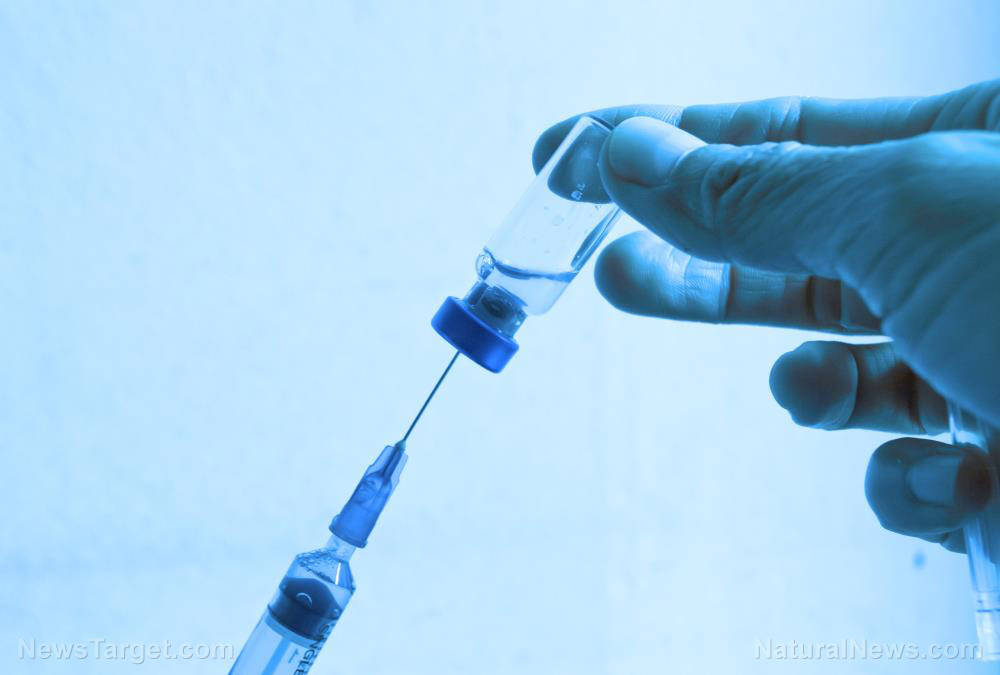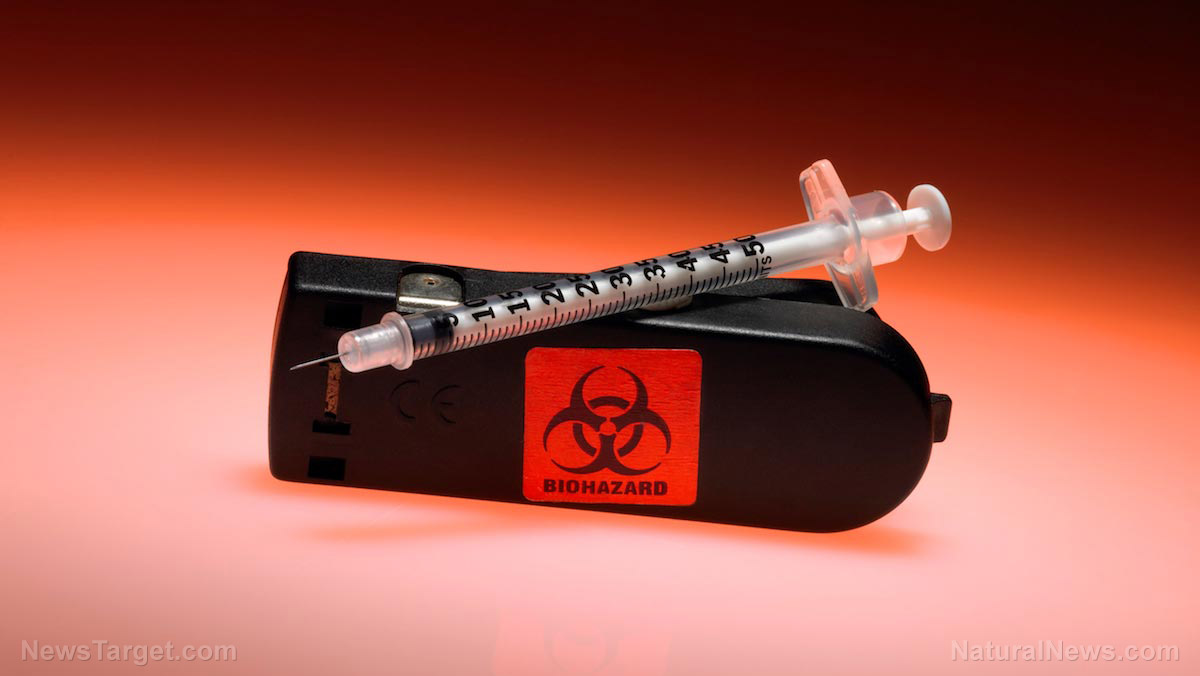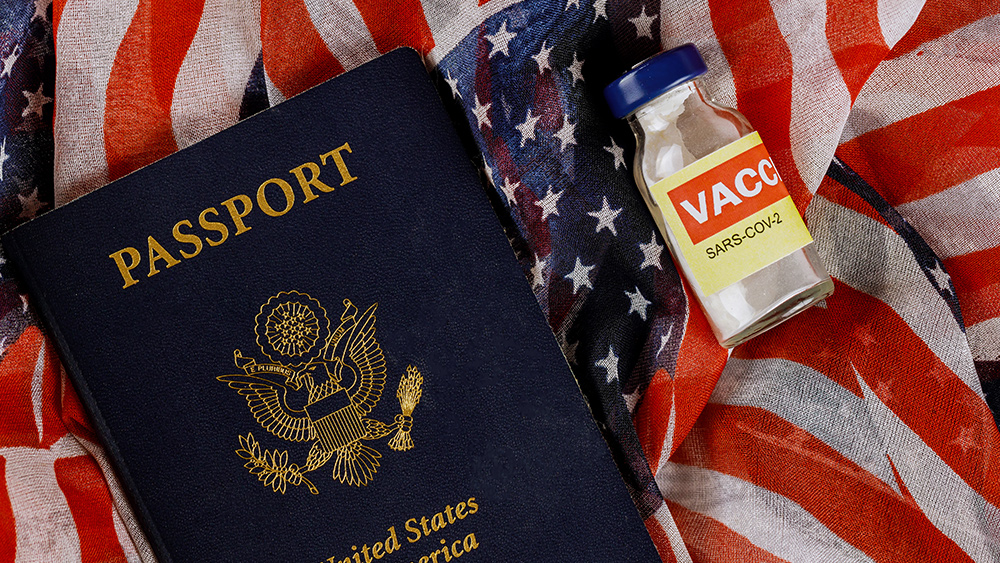'Like watching a horror thriller’: Moving tentacled object, metallic fragments found in COVID jabs - LifeSiteNews
By newseditors // 2021-11-01
Tweet
Share
Copy

An internist who looked at several COVID jabs under a microscope is sounding the alarm after her discovery of strange, unidentified objects in the shots, including metallic fragments, "graphene-like" structures in each jab, and a tentacled, moving organism-like creature in the Moderna jab.
(Article by Emily Mangiaracina republished from LifeSiteNews.com)
Dr. Carrie Madej, who said she has examined the magnified contents of the Moderna, Pfizer, and Johnson & Johnson shots, found it "very upsetting" to see things in each jab that the manufacturers have not been forthright about — so upsetting that she said she cried after she verified with a second batch of shots what she had seen in the first.
She explained on the Stew Peters show that she was first asked by a local Georgia lab to examine under a microscope the contents of a "fresh" Moderna vial, which she verified was unaltered before being placed onto a glass slide under a compound microscope. "Nothing was added to the solution, nothing was diluted," she said.
"First it looked just translucent. And then as time went on, over two hours, colors appeared. I had never seen anything like this. There wasn’t a chemical reaction happening. It was a brilliant blue, and royal purple, yellow, and sometimes green," she said.
She later shared that when she asked nanotech engineers what the emerging brilliant colors might come from, the engineers said the "only thing they knew that could do that" was a white light, over time, causing a reaction on "a super-conducting material." In this case, Madej noted, white light came from the microscope itself.
She pointed out that an example of a super-conducting substance would be "an injectable computing system."
Madej went on, "These fibers were appearing more and more. Some of the fibers had a little cube structure on them, I’m not sure what that was. And also metallic fragments were in there. They were not metallic fragments I’m used to seeing. They were exotic. They were very opaque."
In time, Madej said, “all the particulates, all these colors started moving to the edge" of the cover slide. "There was self-assembling going on, things were growing. They looked synthetic."
Madej noticed something else quite strange: "There was one particular object or organism, I’m not sure what to call it, that had tentacles coming from it. It was able to lift itself up off of the glass slide. It appeared to be self-aware, or to be able to grow or move in space."
 She found it disturbing but said she thought, "Maybe that was a fluke in a way, maybe that was just that one vial."
She found it disturbing but said she thought, "Maybe that was a fluke in a way, maybe that was just that one vial."
 They added that in both images "an intricate matrix or mesh of folded translucent flexible sheets can be observed." The researchers concluded although the "microscopy does not provide conclusive evidence," it "provides strong evidence for the probable presence of graphene derivatives."
Graphene oxide, one of the many derivatives of graphene, is praised for qualities that lend themselves well to biomedical applications such as biosensors, drug delivery, and the transfer of genetic material. For example, the Science Advisory Board describes the design by researchers from the National Center for Neuroscience and Technology in China of a "hydrogel containing an RNA vaccine" that used graphene oxide, favored at least in part for its "high drug-loading efficiency" due to its "large surface area."
In fact, a whole study has been dedicated to the "potential of graphene-based materials to combat COVID-19," which states, "Graphene and graphene-related materials (GRMs) exhibit extraordinary physicochemical, electrical, optical, antiviral, antimicrobial, and other fascinating properties that warrant them as potential candidates for designing and development of high-performance components and devices required for COVID-19 pandemic and other futuristic calamities."
Dr. Robert Young, a Ph.D. and naturopathic practitioner, has also examined each available COVID jab with microscopy and x-ray spectroscopy, finding objects in the Pfizer sample that bear similarity to images of graphene oxide. The microscope images and chemical/elemental content he found through x-ray spectroscopy lead him to believe the Pfizer jab contains graphene oxide.
Dr. Ruby has noted that various studies have found toxic effects of graphene oxide, including its tendency to lead to blood clotting.
A 2016 study titled "Toxicity of graphene-family nanoparticles: a general review of the origins and mechanisms has noted that "due to their nanosize, GFNs can reach deeper organs by passing through the normal physiological barriers," such as "the blood-brain barrier and blood-placental barrier."
The study found that "Graphene Oxide (GO) can result in acute inflammation response and chronic injury by interfering with the normal physiological functions of important organs." "Many experiments have shown that GFNs have toxic side effects in many biological applications," it concluded.
The Food and Drug Administration of Taiwan (TFDA)’s own official publication has also noted graphene oxide’s toxic effects.
It should be noted that the Graphene Flagship, funded by the European Union, has described one of the major developments of graphene usage as its contribution to 5G "transmitter and receivers": "Ultra high capacity transmitter and receivers using graphene offer a unique solution to future 5G communications," reads\ the 2018 development on the graphene timeline.
Graphene’s contribution to 5G "data transmitters and receivers" has also been discussed by the Estonian Public Broadcasting science news portal Novaator.
Read more at: LifeSiteNews.com
They added that in both images "an intricate matrix or mesh of folded translucent flexible sheets can be observed." The researchers concluded although the "microscopy does not provide conclusive evidence," it "provides strong evidence for the probable presence of graphene derivatives."
Graphene oxide, one of the many derivatives of graphene, is praised for qualities that lend themselves well to biomedical applications such as biosensors, drug delivery, and the transfer of genetic material. For example, the Science Advisory Board describes the design by researchers from the National Center for Neuroscience and Technology in China of a "hydrogel containing an RNA vaccine" that used graphene oxide, favored at least in part for its "high drug-loading efficiency" due to its "large surface area."
In fact, a whole study has been dedicated to the "potential of graphene-based materials to combat COVID-19," which states, "Graphene and graphene-related materials (GRMs) exhibit extraordinary physicochemical, electrical, optical, antiviral, antimicrobial, and other fascinating properties that warrant them as potential candidates for designing and development of high-performance components and devices required for COVID-19 pandemic and other futuristic calamities."
Dr. Robert Young, a Ph.D. and naturopathic practitioner, has also examined each available COVID jab with microscopy and x-ray spectroscopy, finding objects in the Pfizer sample that bear similarity to images of graphene oxide. The microscope images and chemical/elemental content he found through x-ray spectroscopy lead him to believe the Pfizer jab contains graphene oxide.
Dr. Ruby has noted that various studies have found toxic effects of graphene oxide, including its tendency to lead to blood clotting.
A 2016 study titled "Toxicity of graphene-family nanoparticles: a general review of the origins and mechanisms has noted that "due to their nanosize, GFNs can reach deeper organs by passing through the normal physiological barriers," such as "the blood-brain barrier and blood-placental barrier."
The study found that "Graphene Oxide (GO) can result in acute inflammation response and chronic injury by interfering with the normal physiological functions of important organs." "Many experiments have shown that GFNs have toxic side effects in many biological applications," it concluded.
The Food and Drug Administration of Taiwan (TFDA)’s own official publication has also noted graphene oxide’s toxic effects.
It should be noted that the Graphene Flagship, funded by the European Union, has described one of the major developments of graphene usage as its contribution to 5G "transmitter and receivers": "Ultra high capacity transmitter and receivers using graphene offer a unique solution to future 5G communications," reads\ the 2018 development on the graphene timeline.
Graphene’s contribution to 5G "data transmitters and receivers" has also been discussed by the Estonian Public Broadcasting science news portal Novaator.
Read more at: LifeSiteNews.com
 She found it disturbing but said she thought, "Maybe that was a fluke in a way, maybe that was just that one vial."
She found it disturbing but said she thought, "Maybe that was a fluke in a way, maybe that was just that one vial."
Some time later, the same lab obtained more vials from a different batch of Moderna shots, as well as a J&J vial. Madej was concerned to see the same things she had observed in the first vial.
"Another one of those tentacle-like structures appeared," she said. "This was now completely under the cover slip, so there was no movement because it wasn’t on the edge, but I just couldn’t believe I saw another one. Same thing." Madej also saw the "same colors" appear over time, as well as the fibers. In the J&J vial, Madej said, there was "definitely a substance that looked like graphene. They all had graphene-like structures in there. Whether or not they were, I don’t have the capability of testing them in order to know at this lab, but that’s what they appeared to be." The vial’s contents also had "fatty substances, a sticky glue-like substance that would be considered a hydrogel in those, both of them." The J&J vial "also had colors appear." "Their colors were different, like a fluorescent pastel kind of color. Again, a lot of synthetic structures in there as well." Madej also noticed many "spherical ring structures" in the J&J contents. "I’ve never seen anything like this before. They’re not supposed to be in these injections. What are they going to do to somebody? What are they going to do to a child? I started crying when I saw these the second time under a microscope, because it was confirmation of everything I saw the first time," Madej said. Madej again appeared on the Stew Peters show on October 20 to discuss her findings from a Pfizer jab vial as well as another J&J vial. "What I’m seeing in all of these manufacturers are synthetic substances, graphene-like, also these nano-carbon tubes," Madej said. "In this particular J&J" vial, Madej saw "round spheres, which were not air bubbles." She continued, "There’s many of these rings, and as time went on they would get thinner and thinner and expand out and then finally extrude out some gelatinous material — I’m not sure what it was, but different kinds of things were inside these spheres. So they’re almost like a delivery structure, that’s what they were doing." On one of these rings, Madej saw what "looked like a translucent organism that went around, and back and forth." Madej first "thought it was another water parasite," but after continuing to observe its movements, "thought perhaps it was moving in a more robotic way." Madej saw the "same kind of synthetic things" in the Pfizer jab, as well as "something that looks similar to teslaphoresis. That’s when these little graphite-like black, metallic particles start to coalesce into strings, like a spider web. They do that through any external force — it could be light, it could be a magnetic force, it could be an impulse, like a frequency. Anyhow, all these little particles would then coalesce and form their own neural network, or their own fibers, or wires." After listening to Madej’s findings and seeing the photo and video documentation she provided, Peters commented, "It’s like I’m watching a seriously bad B-movie, a horror thriller." Are the Moderna jab’s tentacled creatures ‘immortal’ hydra experiments? Madej believes the tentacled entity she found in the Moderna jabs has a connection with the organism hydra vulgaris. "It is one of the model organisms that the transhumanists like to study and look at. They feel that this is an amazing organism for humanity," said Madej, in part because "it’s immortal in the lab setting" and "continuously produces its own stem cells." "It never stops. You can chop it up into little bits, put it in a petri dish and it forms itself again and again," she continued. "They’re thinking, wouldn’t this be great if we could put this inside of a human body’s genome, and then if your hand was chopped off by a trauma, you could grow a new hand." The other reason the transhumanists are interested in the hydra, said Madej, is that it "has its own neural network," that looks like a human nerve, and when [gathered together] "can form a mesh network, they actually can communicate between each other, almost like if you had your own intranet inside your body." She noted that then "something outward could affect it, like an impulse, a frequency, something from 5G, a light, a magnet. What if something influenced that communication network?" On October 21, Karen Kingston pointed out on the Stew Peters show that the National Institutes of Health (NIH), which owns a 50% stake in Moderna’s mRNA-1273 vaccine and it helped develop under the National Institute of Allergy and Infectious Diseases (NIAID) led by Dr. Anthony Fauci, "has been sponsoring research on hydra for more than two decades." In fact, the NIH has an entire subsection of its website dedicated to the Hydra 2.0 Genome Project. Kingston also pointed to a study that found that Hydra has "about the same number of genes as humans, sharing many of the same ones," and that they also found in the Hydra genes "linked with Huntington’s disease" and with plaque formation seen in Alzheimer’s disease. She compared the symptoms associated with these diseases with those being experienced by some who have received the COVID jabs, such as body tremors, in those who have "lost control of their neurological system." She believes people are being injected through the COVID shots with "transgenic hydra," which she describes as an organism with DNA from another organism incorporated into it. Another doctor’s ‘delivery structure’ findings in Johnson & Johnson jab Madej is not the first to observe metallic unidentified objects, graphene-like substances, self-assembling particles, and organism-like entities in the COVID jabs. Dr. Jane Botha reported on the Stew Peters show on October 4 that when she put a drop from a J&J shot vial under the microscope and left the droplet uncovered, she saw "very symmetrical black discs" that "seem to be joined together," by what Peters noted appeared to be metal connectors. Botha did not know what to make of what she was seeing, but noted that they reflected light when observed under a dark field, and that they appeared to be "self-assembling." She saw the same discs four different times, using four different droplets from the same vial. When the sample dried, said Botha, she could no longer see the disc structures, but "black lines started to form." Botha was especially disturbed by what she found because when she viewed the jab fluid through a different microscope technique, more amorphous-looking "black structures" appeared to be "exactly the same structure" that she observed in the blood of her jabbed patients who were experiencing symptoms after the COVID shots. These symptoms included blood clots, shortness of breath, nerve pain, severe thrombosis, severe embolisms, and cognitive difficulties, including memory loss and depression. Pharmaceutical researcher Dr. Jane Ruby shared on the Stew Peters show on October 6 that people have done "reverse searches" and have "put a lot of different science together to show that this is a technology that’s called micro-bubbles," which she says is a delivery system used for the human body. Ruby said Dr. Botha "is hypothesizing" that the reason she could no longer see the discs, but only black lines once the J&J jab sample dried up, is that "maybe they were programmed to break open" and "spill over their contents, their payload." This hypothesis would correspond with Dr. Madej’s observation in the J&J jab sample of "rings" that "as time went on they would get thinner and thinner and expand out and then finally extrude out some gelatinous material," which she described as "almost like a delivery structure." The International Journal of Pharmaceutical Sciences and Research has published an "overview" of "the concept of microbubble as a drug delivery system," describing microbubbles as a "small spherical type of bubble" "capable of penetrating even into the smallest blood capillaries & releasing drugs or genes, incorporated on their surface, under the action of ultrasound." Repeated findings of graphene oxide-like substances in jabs Others have observed substances in the COVID jabs that they believe to be graphene oxide, which has been shown in various experiments to have toxic effects. The first such finding to come to prominence was the observation by Dr. Pablo Campra Madrid, published in the Spanish blog La Quinta Columna, that the contents of what was labeled as a Pfizer jab, as viewed under an electron microscope, "present[ed] a high similarity with images of graphene oxide from the literature obtained by the same TEM technique, with similar magnifications." They added that in both images "an intricate matrix or mesh of folded translucent flexible sheets can be observed." The researchers concluded although the "microscopy does not provide conclusive evidence," it "provides strong evidence for the probable presence of graphene derivatives."
Graphene oxide, one of the many derivatives of graphene, is praised for qualities that lend themselves well to biomedical applications such as biosensors, drug delivery, and the transfer of genetic material. For example, the Science Advisory Board describes the design by researchers from the National Center for Neuroscience and Technology in China of a "hydrogel containing an RNA vaccine" that used graphene oxide, favored at least in part for its "high drug-loading efficiency" due to its "large surface area."
In fact, a whole study has been dedicated to the "potential of graphene-based materials to combat COVID-19," which states, "Graphene and graphene-related materials (GRMs) exhibit extraordinary physicochemical, electrical, optical, antiviral, antimicrobial, and other fascinating properties that warrant them as potential candidates for designing and development of high-performance components and devices required for COVID-19 pandemic and other futuristic calamities."
Dr. Robert Young, a Ph.D. and naturopathic practitioner, has also examined each available COVID jab with microscopy and x-ray spectroscopy, finding objects in the Pfizer sample that bear similarity to images of graphene oxide. The microscope images and chemical/elemental content he found through x-ray spectroscopy lead him to believe the Pfizer jab contains graphene oxide.
Dr. Ruby has noted that various studies have found toxic effects of graphene oxide, including its tendency to lead to blood clotting.
A 2016 study titled "Toxicity of graphene-family nanoparticles: a general review of the origins and mechanisms has noted that "due to their nanosize, GFNs can reach deeper organs by passing through the normal physiological barriers," such as "the blood-brain barrier and blood-placental barrier."
The study found that "Graphene Oxide (GO) can result in acute inflammation response and chronic injury by interfering with the normal physiological functions of important organs." "Many experiments have shown that GFNs have toxic side effects in many biological applications," it concluded.
The Food and Drug Administration of Taiwan (TFDA)’s own official publication has also noted graphene oxide’s toxic effects.
It should be noted that the Graphene Flagship, funded by the European Union, has described one of the major developments of graphene usage as its contribution to 5G "transmitter and receivers": "Ultra high capacity transmitter and receivers using graphene offer a unique solution to future 5G communications," reads\ the 2018 development on the graphene timeline.
Graphene’s contribution to 5G "data transmitters and receivers" has also been discussed by the Estonian Public Broadcasting science news portal Novaator.
Read more at: LifeSiteNews.com
They added that in both images "an intricate matrix or mesh of folded translucent flexible sheets can be observed." The researchers concluded although the "microscopy does not provide conclusive evidence," it "provides strong evidence for the probable presence of graphene derivatives."
Graphene oxide, one of the many derivatives of graphene, is praised for qualities that lend themselves well to biomedical applications such as biosensors, drug delivery, and the transfer of genetic material. For example, the Science Advisory Board describes the design by researchers from the National Center for Neuroscience and Technology in China of a "hydrogel containing an RNA vaccine" that used graphene oxide, favored at least in part for its "high drug-loading efficiency" due to its "large surface area."
In fact, a whole study has been dedicated to the "potential of graphene-based materials to combat COVID-19," which states, "Graphene and graphene-related materials (GRMs) exhibit extraordinary physicochemical, electrical, optical, antiviral, antimicrobial, and other fascinating properties that warrant them as potential candidates for designing and development of high-performance components and devices required for COVID-19 pandemic and other futuristic calamities."
Dr. Robert Young, a Ph.D. and naturopathic practitioner, has also examined each available COVID jab with microscopy and x-ray spectroscopy, finding objects in the Pfizer sample that bear similarity to images of graphene oxide. The microscope images and chemical/elemental content he found through x-ray spectroscopy lead him to believe the Pfizer jab contains graphene oxide.
Dr. Ruby has noted that various studies have found toxic effects of graphene oxide, including its tendency to lead to blood clotting.
A 2016 study titled "Toxicity of graphene-family nanoparticles: a general review of the origins and mechanisms has noted that "due to their nanosize, GFNs can reach deeper organs by passing through the normal physiological barriers," such as "the blood-brain barrier and blood-placental barrier."
The study found that "Graphene Oxide (GO) can result in acute inflammation response and chronic injury by interfering with the normal physiological functions of important organs." "Many experiments have shown that GFNs have toxic side effects in many biological applications," it concluded.
The Food and Drug Administration of Taiwan (TFDA)’s own official publication has also noted graphene oxide’s toxic effects.
It should be noted that the Graphene Flagship, funded by the European Union, has described one of the major developments of graphene usage as its contribution to 5G "transmitter and receivers": "Ultra high capacity transmitter and receivers using graphene offer a unique solution to future 5G communications," reads\ the 2018 development on the graphene timeline.
Graphene’s contribution to 5G "data transmitters and receivers" has also been discussed by the Estonian Public Broadcasting science news portal Novaator.
Read more at: LifeSiteNews.com
Tweet
Share
Copy
Tagged Under:
vaccines Big Pharma vaccine pandemic vaccine ingredients investigations badhealth COVID
You Might Also Like
WHO director-general shuns vaccine passports, admits shots do not prevent COVID
By Ramon Tomey // Share
Recent News
Silver hits record high amid economic uncertainty, fueling investor frenzy
By kevinhughes // Share
Russia warns of nuclear response as NATO build-up escalates tensions
By patricklewis // Share
South Africa's water crisis: A warning for the world
By patricklewis // Share











